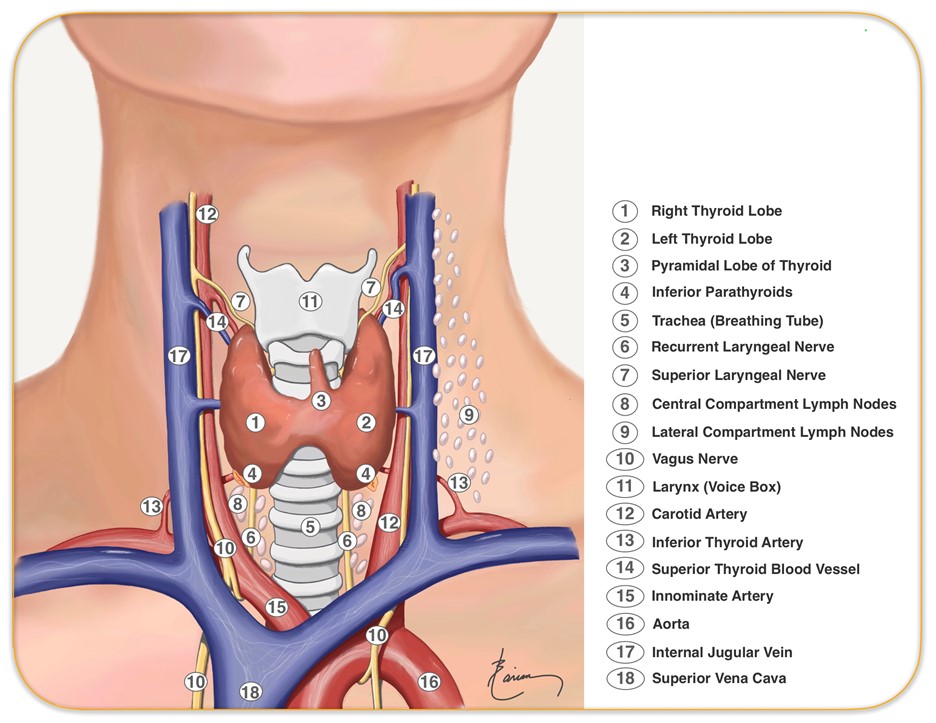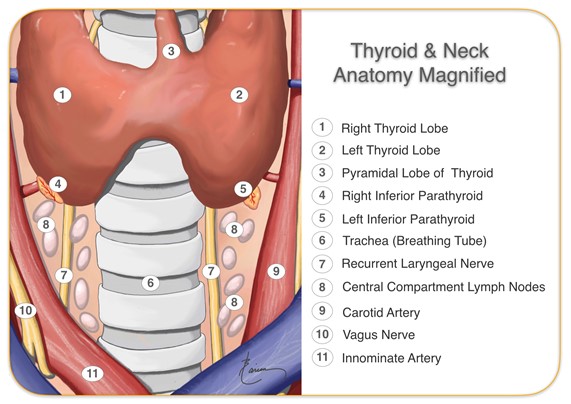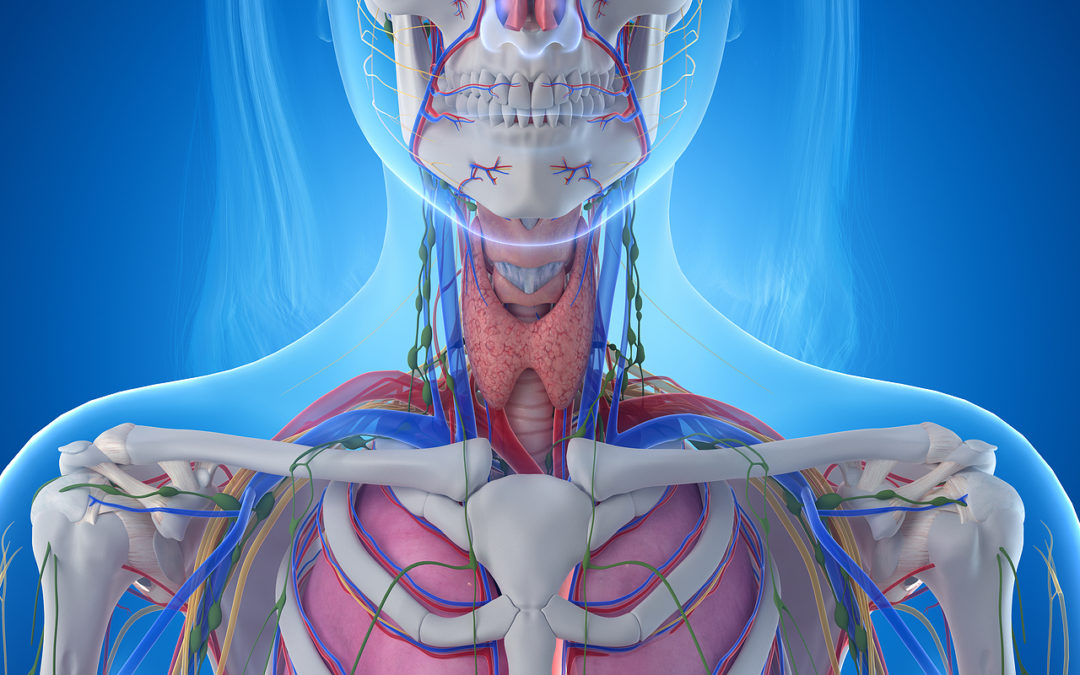Because the parathyroid glands are located in the neck, any physician treating parathyroid problems must thoroughly understand the anatomy of the neck and throat. At the CENTER for Advanced Parathyroid Surgery in Los Angeles, we specialize in diagnosing and treating conditions of this complex part of the body. We find it helpful for our patients to understand the parts of the neck and throat. It’s also important to understand how the neck organs interact with and affect the rest of the body.
In this guide, we’ll walk you through a diagram of the throat and neck. Do you have any further questions about the neck and throat? Contact us today to schedule a consultation with Dr. Babak Larian and the team at the CENTER for Advanced Parathyroid Surgery.
A Diagram of the Throat and Neck
Even though it may seem like common sense, some might be wondering, “Where is your throat located?” The throat is located in the front of the vertebrae in your neck. In the diagram below, you’ll see the parts of the neck and throat, each with its own number and corresponding label. Can you spot the parathyroid glands?

Each parathyroid gland is roughly the size of a rice grain. There are four parathyroid glands located behind the thyroid, which is why they’re difficult to see in this diagram. We’ll take a closer look at the parathyroid glands in a moment. First, let’s explore the different parts of the human throat. Each structure is carefully examined when Dr. Larian diagnoses hyperparathyroidism or other parathyroid conditions. This helps Dr. Larian diagnose or rule out other conditions that affect the neck and throat.
1. Jugular Veins
There are four primary jugular veins: two internal and two external. Jugular veins drain blood from the neck, face, and brain and return it to the heart. The internal jugular veins are deep in the neck and the external jugular veins are immediately under the skin.
2. Vagus Nerves
Vagus nerves are connected to the heart, and digestive tract. They regulate digestion, heart rate, and other internal organ functions.
3. Carotid Arteries
Carotid arteries allow blood to travel to the neck, face, and brain. There are carotid arteries on each side of the neck. Those who place their hand on either side below the jaw line on the neck can feel the pulse of their carotid arteries.
4. Larynx (Voice Box)
The larynx is above the breathing tube that houses the vocal cords. Vocal cords don’t just create our voice. More importantly, they coordinate our breathing and swallowing. The top part of the larynx projects outward and can be felt (Adam’s apple).
6. Recurrent Laryngeal Nerve (RLN)
RLN is a branch of the vagus nerve that controls the movement of the voice box (larynx) muscles. It helps these muscles open and close and adjusts the tension of the vocal cords.
7. Trachea
The trachea, sometimes called the windpipe, is the airway that connects the voice box to airways that lead to the lungs (bronchi).
8. Thymus Gland
The thymus gland is located behind the sternum (breastbone) and in front of the heart. It produces progenitor cells that eventually become T-cells that can destroy cancerous or infected cells. The thymus gland also supports immune system development during the early years of life.
9. Aorta
The aorta supplies oxygenated blood to the circulatory system. It is the body’s main artery.
10. Lymph Nodes
There are hundreds of lymph nodes in the body. The lymph nodes are glands that filter & examine the fluid in-between cells. They contain immune cells that monitor for infections & cancers and attack and destroy any such abnormality.
Along with an evaluation of the anatomy of the throat and neck, the anatomy of the thyroid and parathyroid glands is examined to determine if a patient is dealing with HPT.
A Closer Look at the Thyroid and Parathyroid Glands
The thyroid and parathyroid glands may not have a direct relationship, but it’s helpful to look closely at these vital neck organs because they are so close together. The thyroid is a small, butterfly-shaped gland that produces hormones that regulate the body’s metabolism, temperature, and development. The parathyroid glands, located just behind the thyroid, produce parathyroid hormone (PTH), which regulates calcium in the bloodstream.
Any disruption to the thyroid or parathyroid glands can impact the entire body. If a thyroid or parathyroid gland stops working as expected, people are susceptible to various physical and emotional symptoms.
An overactive thyroid can cause too much thyroid hormone (hyperthyroidism), resulting in symptoms like fatigue, muscle weakness, weight loss, diarrhea, and difficulty tolerating heat. Everything from inflammation of the thyroid (thyroiditis) to small growths on the thyroid can cause hyperthyroidism. When the thyroid doesn’t make enough thyroid hormone (hypothyroidism), patients can experience weight gain, dry skin, constipation, and difficulty tolerating cold temperatures. Thyroiditis, Hashimoto’s disease and recent pregnancy are all risk factors for hypothyroidism.

When the parathyroid glands make too much parathyroid hormone (hyperparathyroidism), a person’s blood calcium levels rise (hypercalcemia). This can lead to joint pain, fatigue, nausea, frequent urination, confusion, and depression. In primary hyperparathyroidism, a benign tumor on one of the parathyroid glands or enlargement of multiple glands causes the glands to become overactive. On the other hand, secondary hyperparathyroidism happens when the body is calcium-deficient due to kidney failure or calcium deficiency. The parathyroid glands overcompensate for the low calcium levels by producing too much PTH. Hypoparathyroidism occurs when the parathyroid glands don’t make enough PTH.
The thyroid gland is a crucial part of the neck and throat, and even though they’re much smaller, the parathyroid glands are essential, too. Any disturbance with either of these neck organs can wreak havoc on the body. Parathyroid conditions, in particular, can be challenging to diagnose because the symptoms caused by hyperparathyroidism are similar to the symptoms for a range of health conditions. At the CENTER for Advanced Parathyroid Surgery, Dr. Larian can provide the diagnostics and testing needed to figure out what’s going on with the parathyroid glands. He can also help rule out any other conditions affecting the parts of the human throat.
Impact of Parathyroid Disease on the Throat and Neck Anatomy
Parathyroid disease can occur for several reasons, including:
- Noncancerous growth on a parathyroid gland
- Abnormal growth (hyperplasia) of parathyroid cells in a parathyroid gland
- Cancerous tumor in a parathyroid gland
HPT occurs when one or more parathyroid glands produce an excess amount of PTH. In this instance, the body’s calcium level becomes unbalanced. The result: different structures of the neck and throat can stop functioning correctly.
The symptoms of HPT range in terms of severity. They can include:
- Chronic fatigue
- Bone pain
- Headaches
- Poor sleep
- Anxiety
- Depression
- Muscle weakness
HPT symptoms replicate those of many medical conditions. As such, it can be difficult to diagnose HPT.
For those who believe they are dealing with HPT, meeting with Dr. Babak Larian of the CENTER for Advanced Parathyroid Surgery is key. Dr. Larian is a parathyroid disease expert and can conduct extensive testing to determine if HPT is causing a patient’s symptoms. If a patient is dealing with HPT, Dr. Larian can perform minimally invasive parathyroidectomy (MIP) surgery to address the issue.
Advances in Throat and Neck Disorder Treatment
After learning more about the anatomy of the neck and throat, it might seem extra stressful to have surgery on your throat. But advances in surgical techniques mean that many types of throat surgery are minimally invasive procedures that do not require a hospital stay. In addition, minimally invasive techniques help lower the risk of complications, shorten recovery time, and reduce patient discomfort. These techniques often result in more positive outcomes for patients.
Minimally invasive techniques in head and neck surgeries dealing with the sinuses, larynx, trachea, thyroid gland, and parathyroid glands are common. At the CENTER for Advanced Parathyroid Surgery, Dr. Babak Larian performs minimally invasive parathyroid surgery (parathyroidectomy) to treat hyperparathyroidism. He takes his time with each parathyroid surgery patient he treats, using intraoperative PTH testing to ensure a high cure rate.
A highly experienced and empathetic head and neck surgeon, Dr. Larian can help patients understand what is happening with their parathyroid glands and other parts of the neck and throat. Dr. Larian is a parathyroid disease expert and can conduct extensive testing to determine if HPT is causing a patient’s symptoms. If a patient is dealing with HPT, Dr. Larian can perform minimally invasive parathyroidectomy (MIP) surgery to address the issue.
If you are experiencing symptoms of hyperparathyroidism, you can meet with Dr. Larian to find out if you qualify for a MIP. For more information about parathyroid gland surgery, please contact us online or call us today at 310-461-0300 to schedule a consultation with Dr. Larian.










